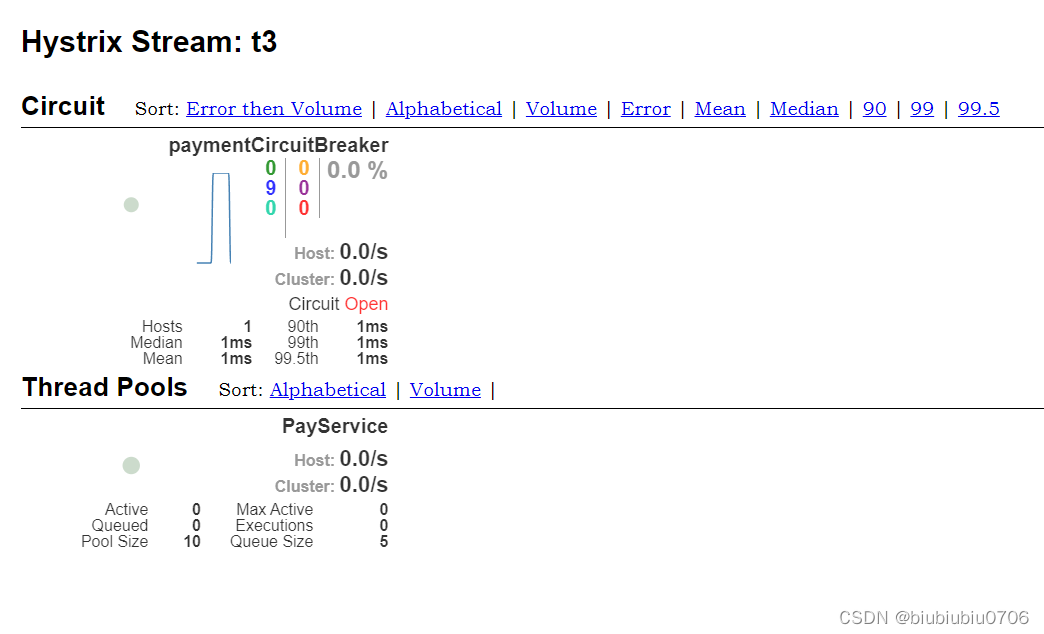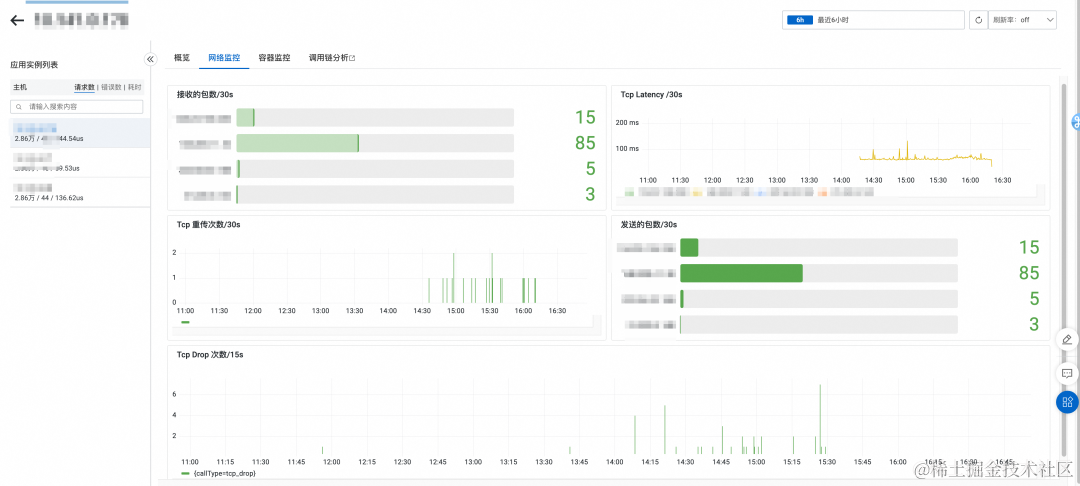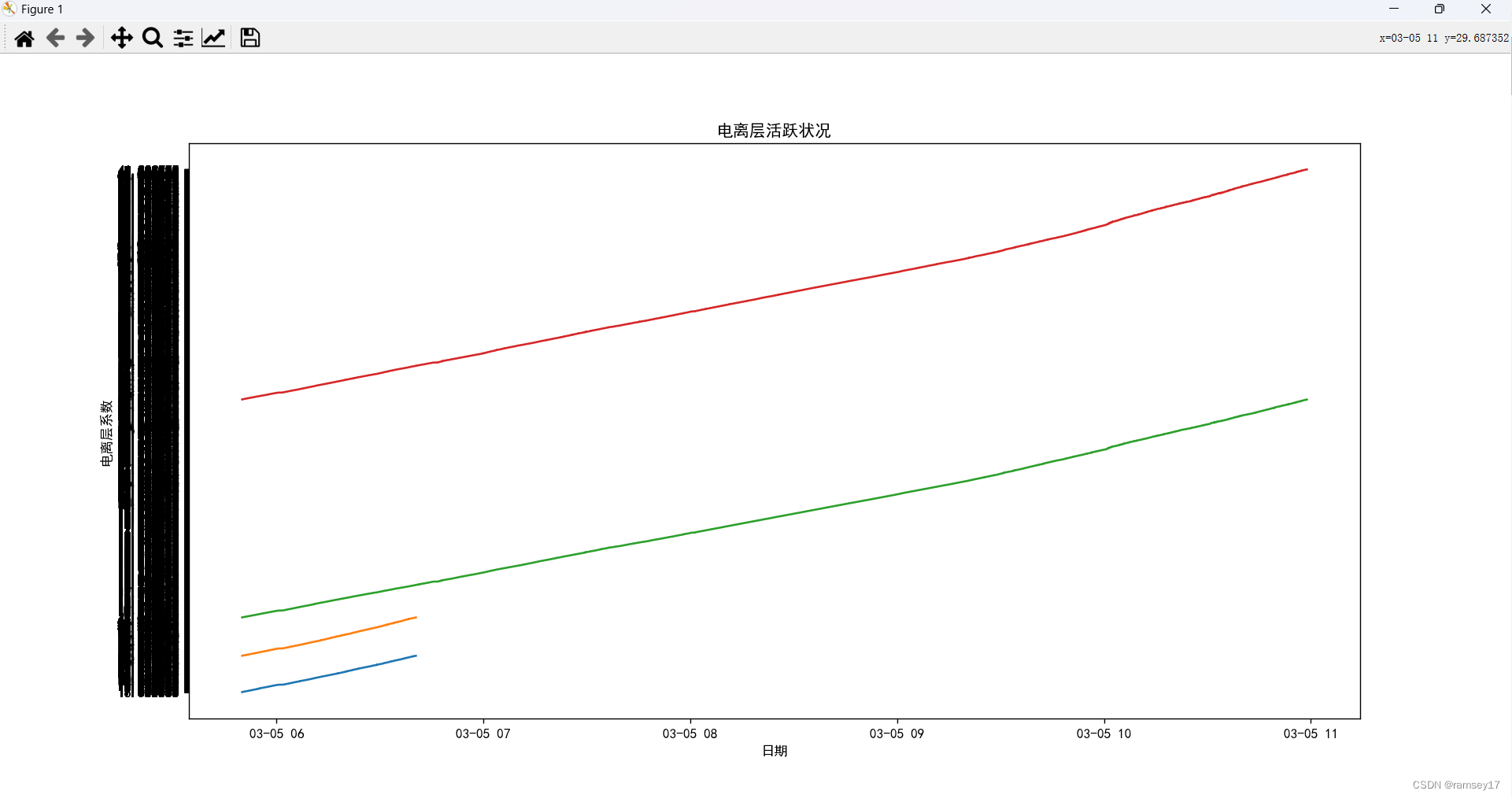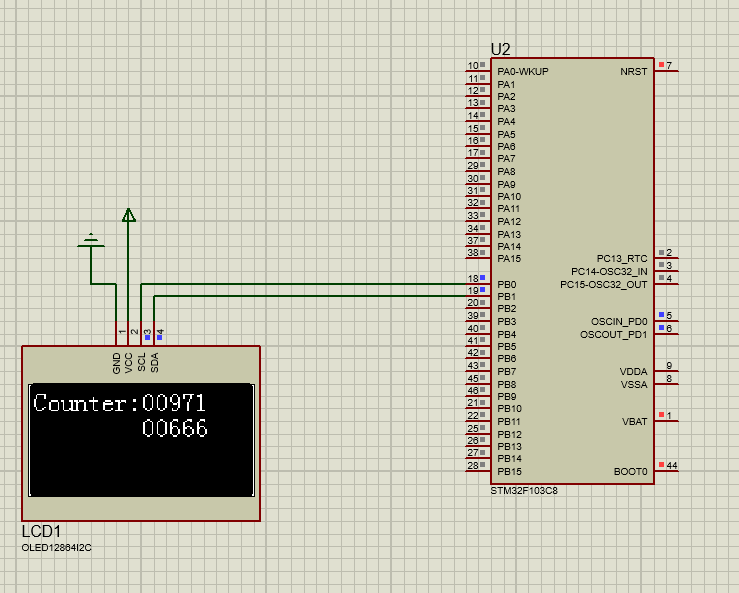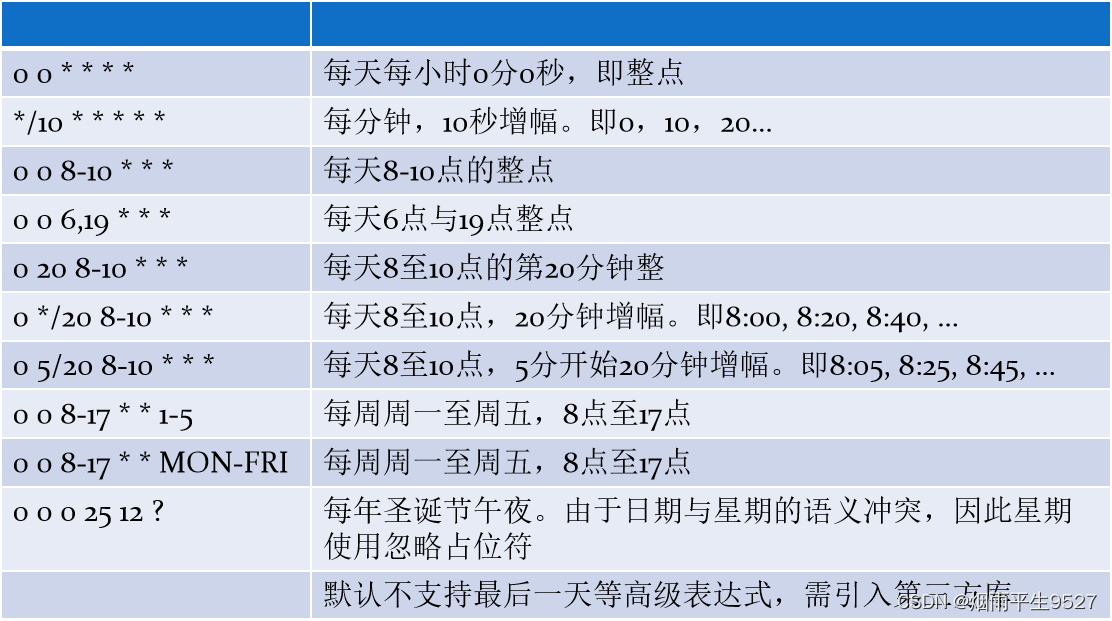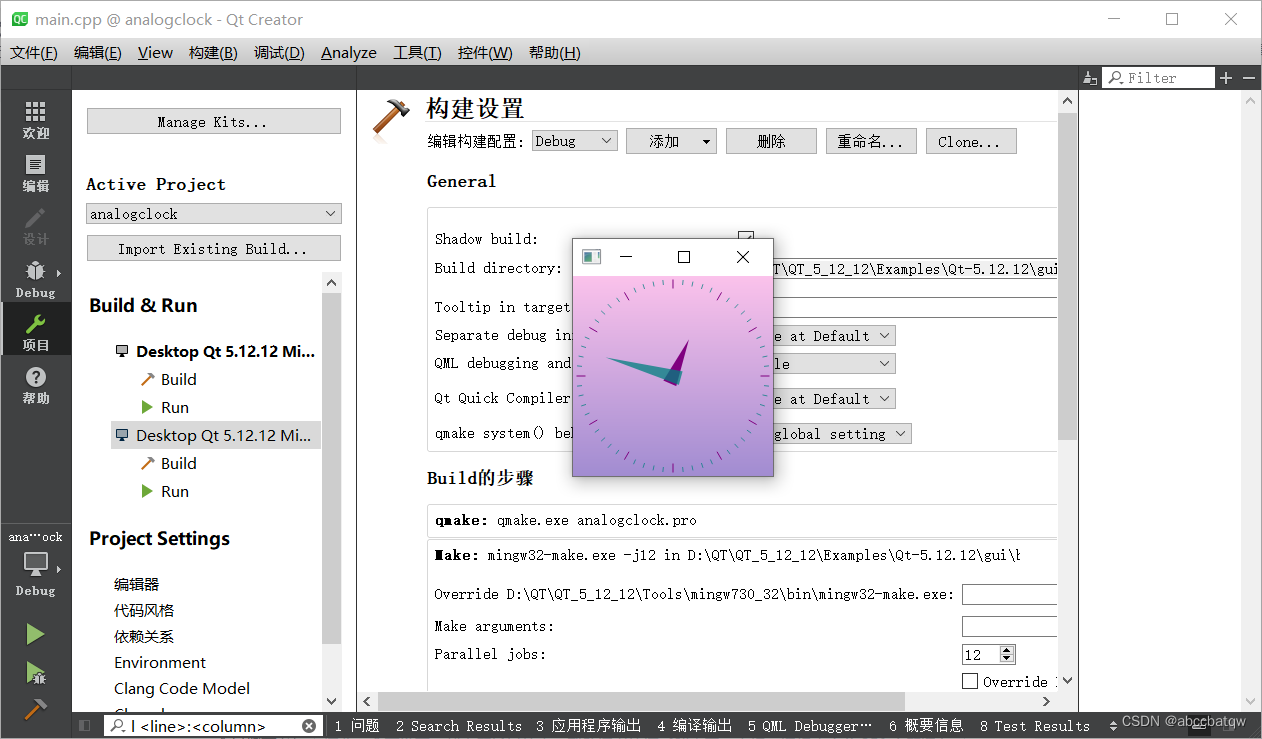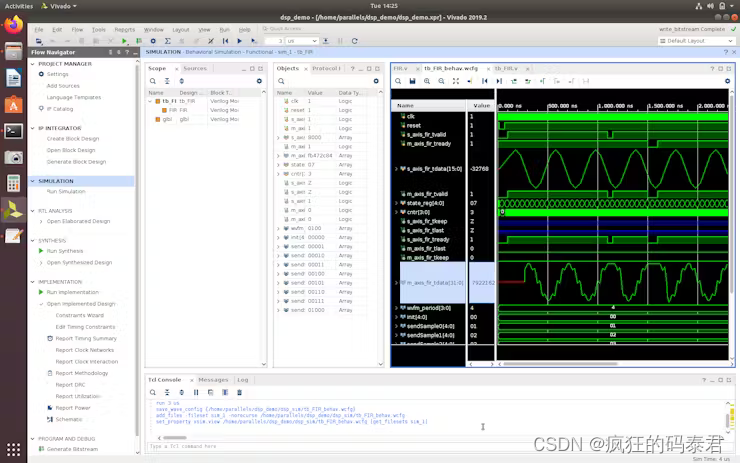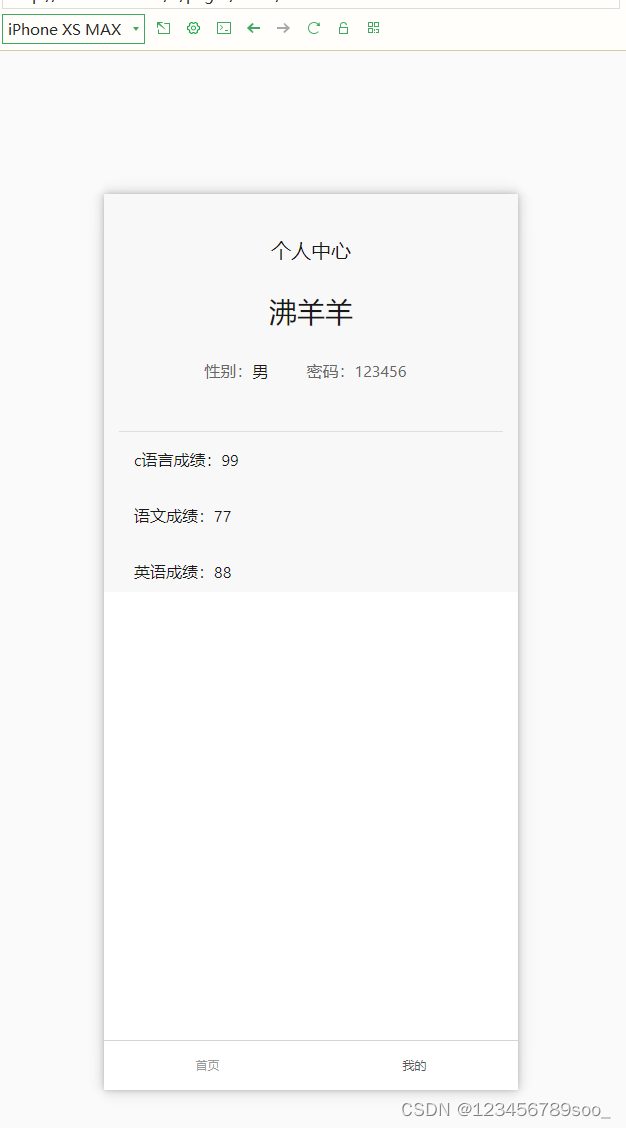1,类型分区模型
c++程序在执行中,将内存大方向划分为4个区域
1,代码区:存放函数体的二进制代码,由操作系统进行管理的
2,全局区:存放全局变量和静态变量以及常量
3,栈区:由编译器自动分配释放,存放函数的参数值,局部变量等
4,堆区:由程序员分配和释放,若程序员不释放,程序结束时由操作系统回收
内存四区的意义:
不同区域存放的数据,赋予不同的声明周期,给我们更大的灵活编程
1.1 程序运行前
在程序编译后,生成exe可执行程序,未执行程序前分两个区域:
代码区:
存放CPU执行的机器指令
代码区是共享的,共享的目的是对于频繁被执行的程序,只需要在内存中有一份代码即可
代码区是只读的,使其只读的原因是防止程序意外地修改了它的指令
全局区:
全局变量和静态变量存放于此
全局区还包含了常量区,字符串常量和其他常量也存放于此
该区域的数据在程序结束后由操作系统操作
代码展示:
#include<iostream>
using namespace std;
//全局变量
int g_a = 10;
int g_b = 10;
int main()
{
//全局区
//全局变量,静态变量,常量
//创建普通局部变量
int a = 10;
int b = 10;
cout << "局部变量a的地址:" << &a << endl;
cout << "局部变量b的地址:" << &b << endl;
cout << endl;
cout << "全局变量g_a的地址:" << &g_a << endl;
cout << "全局变量g_b的地址:" << &g_b << endl;
cout << endl;
//静态变量 在普通变量前加static,属于静态变量
static int s_a = 10;
static int s_b = 10;
cout << "静态变量s_a的地址:" << &s_a << endl;
cout << "静态变量s_b的地址:" << &s_b << endl;
cout << endl;
//常量
//字符串常量
cout << "字符串常量的地址为:" << &"hello world" << endl;
cout << endl;
//const修饰的变量
//const修饰的全局变量
const int c_g_a = 10;
const int c_g_b = 10;
cout << "全局常量 c_g_a的地址:" << &c_g_a << endl;
cout << "全局常量 c_g_b的地址:" << &c_g_b << endl;
cout << endl;
//const修饰的局部变量
const int c_l_a = 10;
const int c_l_b = 10;
cout << "全局常量 c_g_a的地址:" << &c_l_a << endl;
cout << "全局常量 c_g_b的地址:" << &c_l_b << endl;
cout << endl;
system("pause");
return 0;
}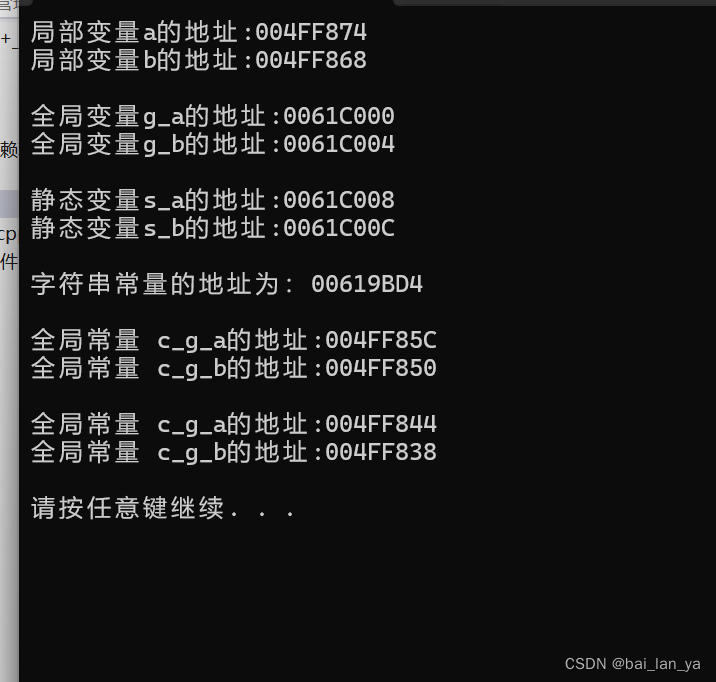
 总结:
总结:
c++中程序运行前分为全局区和代码区
代码区的特点是共享和只读
全局区中存放全局变量,静态变量,常量
常量区中存放const修饰的全局变量和字符串变量
1.2 程序运行后
栈区:由编译器自动分配释放,存放函数的参数值,局部变量等
注意:不要返回局部变量的地址,栈区开辟的数据由编译器自动释放
int* func()
{
//利用new关键字 可以将数据开辟到堆区
//指针,本质也是局部变量,放在栈区,指针保存的数据是放在栈区
int* a = new int(10);
return a;
}
int main()
{
//在堆区开辟数据
int* p = func();
cout << "第一个:" << *p << endl;//每一次都会保存正确的数据
cout << "第二个:" << *p << endl;
cout << "第二个:" << *p << endl;
cout << "第二个:" << *p << endl;
cout << "第二个:" << *p << endl;
cout << "第二个:" << *p << endl;
cout << "第二个:" << *p << endl;
system("pause");
return 0;
}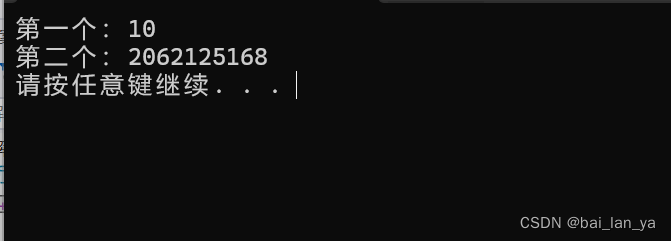
堆区:
由程序员分配释放,若 程序员不释放,程序结束时由操作系统释放
在C++中主要利用new在堆区开辟内存
示例:
int* func()
{
int* a = new int(10);
return a;
}
int main()
{
int* p = func();
cout << "第一个:" << *p << endl;//每一次都会保存正确的数据
cout << "第二个:" << *p << endl;
cout << "第二个:" << *p << endl;
cout << "第二个:" << *p << endl;
cout << "第二个:" << *p << endl;
cout << "第二个:" << *p << endl;
cout << "第二个:" << *p << endl;
system("pause");
return 0;
}
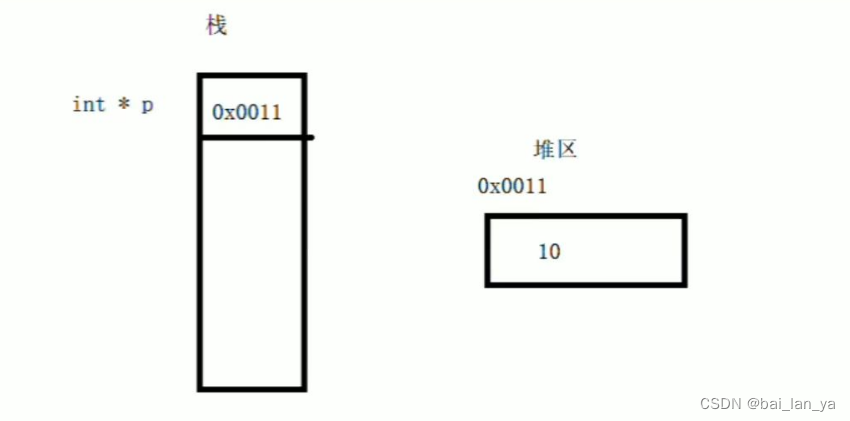
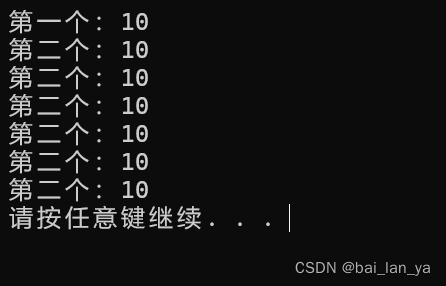
1.3 new操作符
C++中利用new操作符在堆区开辟数据
堆区开辟的数据,由程序员手动开辟,释放利用操作符delete
语法: new 数据类型
利用new创建的数据,会返回该数据对应的类型的指针
示例1:基本语法:
#include<iostream>
using namespace std;
//1,new的基本语法
int* func()
{
//在堆区创建整型数据
//new返回是 该数据类型的指针
int* a = new int(10);
return a;
}
int main()
{
int* p = func();
cout << *p << endl;
cout << *p << endl;
cout << *p << endl;
//delete p;
//堆区的数据 由程序员管理开辟,程序员管理释放
//如果向释放堆区的数据,利用关键字 delete
cout << *p << endl;
system("pause");
return 0;
}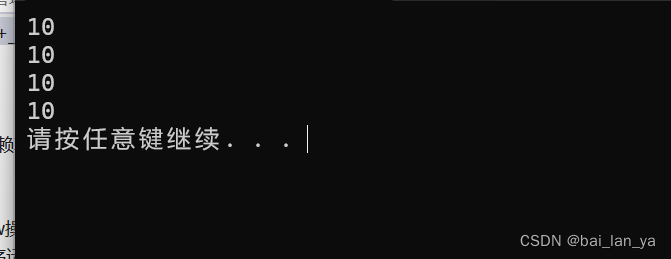

示例2:开辟数组
//2,开辟数组
int main()
{
int* arr = new int[10];
for (int i = 0; i < 10; i++)
{
arr[i] = i + 100;
}
for (int i = 0; i < 10; i++)
{
cout << arr[i] << endl;
}
delete[] arr;//释放数组 delete后加[]
//int* arr = new int[10];
/*for (int i = 0; i < 10; i++)//释放后不能再次使用
{
arr[i] = i + 100;
}
for (int i = 0; i < 10; i++)
{
cout << arr[i] << endl;
}*/
system("pause");
return 0;
}
2,引用
2.1 引用的基本使用
作用:给变量起别名
语法:数据类型 &别名 = 原名;

示例:
#include<iostream>
using namespace std;
int main()
{
//引用的基本语法
//数据类型 &别名 = 原名
int a = 10;
//创建引用
int& b = a;
cout << "a=" << a << endl;
cout << "b=" << b << endl;
b = 100;
cout << "a=" << a << endl;
cout << "b=" << b << endl;
system("pause");
return 0;
}
2.2 引用的注意事项
引用必须初始化
引用在初始化后,不可以改变
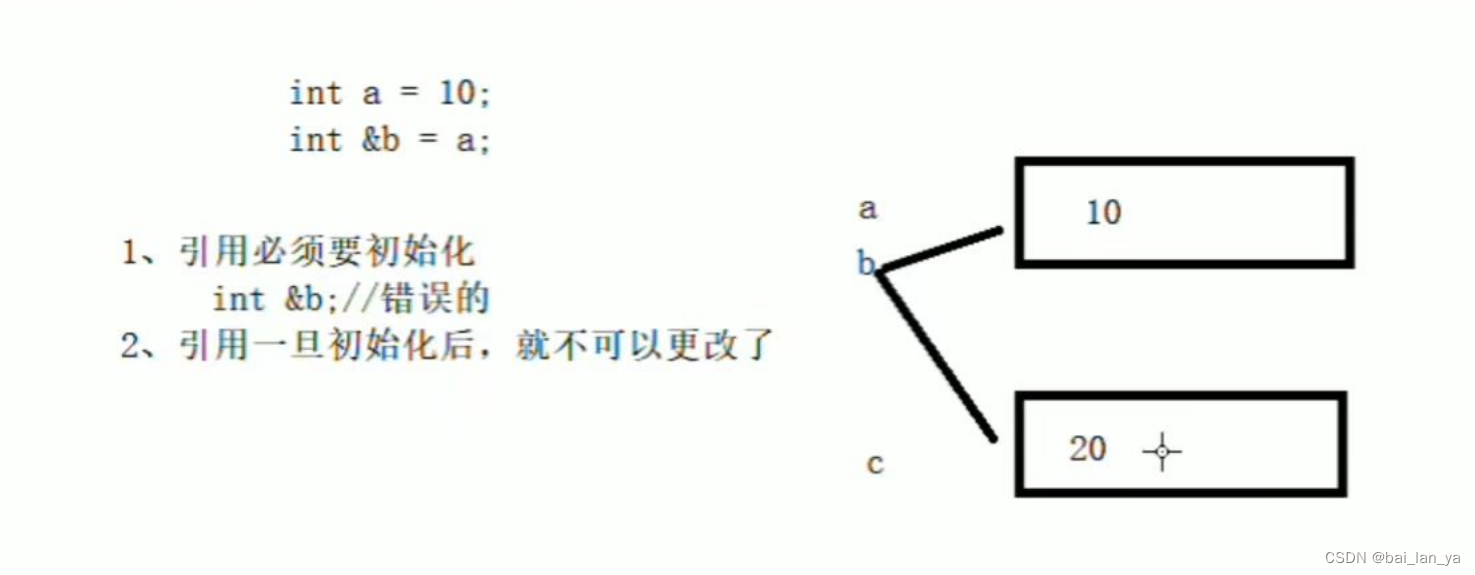
int main()
{
int a = 10;
int b = 10;
//int& c;//报错,引用必须初始化
int& c=a;//一旦初始化后,就不可以更改
c = b;//这是赋值操作,不是更改引用
cout << "a=" << a << endl;
cout << "b=" << b << endl;
cout << "c=" << c << endl;
system("pause");
return 0;
}
2.3 引用做函数参数
作用:函数传参是,可以利用引用的技术让形参修饰实参
优点:可以简化指针修饰实参
示例:
//引用做函数参数
//1,值传递
void Swap01(int a,int b)
{
int temp = a;
a = b;
b = temp;
cout << "a= " << a << endl;
cout << "b= " << b << endl;
cout << endl;
}
//2,地址传递
void Swap02(int* a, int* b)
{
int temp = *a;
*a = *b;
*b = temp;
cout << "a= " << *a << endl;
cout << "b= " << *b << endl;
cout << endl;
}
//3,引用传递
void Swap03(int& a, int& b)
{
int temp = a;
a = b;
b = temp;
cout << "a= " << a << endl;
cout << "b= " << b << endl;
cout << endl;
}
int main()
{
Swap01(10,20);//值传递,形参不会修饰实参
int a = 30;
int b = 40;
cout << "a= " << a << endl;
cout << "b= " << b << endl;
cout << endl;
Swap02(&a,&b);//地址传递,形参会修饰实参
cout << "a= " << a << endl;
cout << "b= " << b << endl;
cout << endl;
a = 50;
b = 60;
Swap03(a, b);//引用传递,形参会修饰实参
cout << "a= " << a << endl;
cout << "b= " << b << endl;
cout << endl;
system("pause");
return 0;
}

总结:通过引用参数产生的效果同按地址传递是一样的。
引用的语法更清楚
2.4 引用做函数返回值
作用:引用时可以作为函数的返回值存在的
注意:不要返回局部变量引用
用法:函数调用作为左值
示例1:
1,不要返回局部变量的引用
int& test01()
{
int a = 10; //局部变量放在四区中的栈区
return a;
}
int main()
{
int &ref = test01();
cout << "ref= " << ref << endl;//第一次结果正确,是因为编译器做了保留
cout << "ref= " << ref << endl;//第二次结果错误,是因为a的内存已经释放
system("pause");
return 0;
}
示例二:
//函数的调用可以作为左值
int& test02()
{
static int a = 10; //静态变量存放在全局区,全局区上的数据在程序结束后系统释放
return a;
}
int main()
{
int& ref = test02();
cout << "ref= " << ref << endl;
cout << "ref= " << ref << endl;
test02() = 1000;//如果函数的返回值是引用,这个函数调用可以作为左值
cout << "ref= " << ref << endl;
cout << "ref= " << ref << endl;
system("pause");
return 0;
}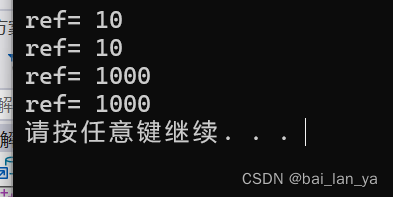
2.5 引用的本质
本质:引用的本质在c++内部实现是一个指针常量
示例:
//引用的本质
//发现是引用,转换为int* const ref = &a;
void func(int& ref)
{
ref = 100;//ref是引用,转换为*ref = 100;
}
int main()
{
//自动转化为int* const ref = &a;指针常量是指针指向不可改,也说明为什么引用不可以更改
int a = 10;
int& ref = a;
ref = 20;//内部发现ref是引用,自动帮我们转换为*ref=20;
cout << "a= " << a << endl;
cout << "ref= " << ref << endl;
func(a);
cout << "a= " << a << endl;
cout << "ref= " << ref << endl;
system("pause");
return 0;
}
结论:C++推荐引用技术,因为语法方便,引用本质是常量指针
2.6 常量引用
作用:常量引用主要用来修饰形参,防止误操作
在函数形参列表中,我们可以加const修饰形参,防止形参改变实参
示例:
//引用使用的场景,通常用来修饰形参
void showValue(const int& v)
{
//v += 10;
cout <<"v= "<< v << endl;
}
int main()
{
//int& ref = 10;//引用本身需要一个合法的内存空间,因此这行错误
//加入const就可以了,编译器做了优化代码,int temo = 10;const int& ref = temp;
const int& ref = 10;
cout << "ref= "<<ref << endl;
//ref=100;//加入const后不可以修改变量
int a = 10;
//函数中利用常量引用防止误操作修改实参
showValue(a);
system("pause");
return 0;
}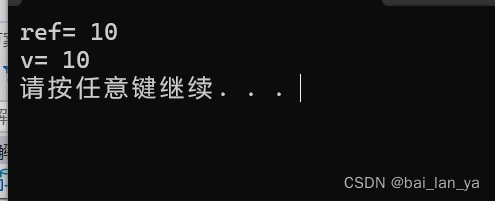
3,函数提高
3.1 函数默认参数
在C++中,函数的形参列表中的形参是由默认值的。
语法:返回值类型 函数名 (参数 = 默认值){}
示例1:
#include<iostream>
using namespace std;
int func1(int a, int b, int c)
{
return a + b + c;
}
//如果我们积极传入数据,就用自己的数据,如果没有,那就用默认值
//b未传入数据,则使用默认值
int func2(int a, int b = 20, int c = 30)
{
return a + b + c;
}
//都传入了数据,那就用自己的数据
int func3(int a, int b, int c)
{
return a + b + c;
}
int main()
{
cout << "func1()的值" << endl;
cout << func1(10, 20, 30) << endl;
cout << endl;
cout << "func2()的值" << endl;
cout << func2(10, 30) << endl;
cout << endl;
cout << "func3()的值" << endl;
cout << func1(30, 40, 50) << endl;
cout << endl;
system("pause");
return 0;
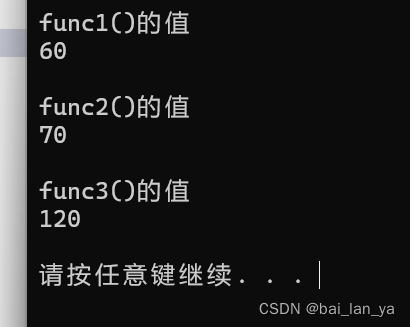
示例2:
//注意事项:
//1,如果某个位置已经有了默认参数,那么从那个位置往后,从左到右必须都有默认值
//int func1(int a=10, int b, int c,int d)//错误
//{
// return a + b + c;
//}
//2,如果函数声明由默认参数,函数实现就不能由默认参数
//int func2(int a=10, int b=10);
//声明和实现都能有一个默认参数
int func2(int a=10, int b=20)
{
return a + b;
}
int main()
{
cout << func2(10) << endl;
return 0;
}3.2函数占位参数
C++中函数的形参列表里可以有占位参数,用来做占位,调用函数时必须填补该位置
语法:返回值类型 函数名 (函数类型){ }
在现阶段函数的占位参数存在意义不大,但是后面的课程中会用到该技术
示例:
//函数占位参数,占位参数也可以有默认参数
void func(int a, int)
{
cout << "this is func" << endl;
}
int main()
{
func(10, 10);//占位参数必须填补
system("pause");
}
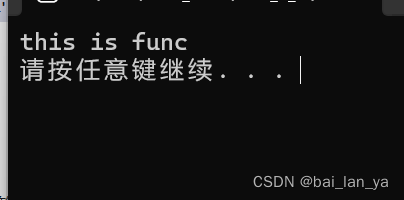
3.3 函数重载
void func()
{
cout << "func的调用" << endl;
}
void func(int a)
{
cout << "func的调用" << endl;
}
void func(double a)
{
cout << "func的调用" << endl;
}
//函数返回值不能作为函数重载条件
//int func(double a,int b)
//{
// cout << " func(double a,int b)" << endl;
//}
int main()
{
//func()
func(10);
func(3.14);
}作用:函数名可以相同,提高复用性
3.3.1函数重载满足条件:
1,同一个作用域下
2,函数名相同
3,函数参数类型不同或者个数不同或者顺序不同
注意:函数的返回值不可以作为函数重载的条件
void func()
{
cout << "func的调用" << endl;
}
void func(int a)
{
cout << "func的调用" << endl;
}
void func(double a)
{
cout << "func的调用" << endl;
}
//函数返回值不能作为函数重载条件
//int func(double a,int b)
//{
// cout << " func(double a,int b)" << endl;
//}
int main()
{
//func()
func(10);
func(3.14);
}3.3.2 函数重载注意事项
1,引用作为重载条件
2,函数重载碰到函数默认条件
示例:
// 函数重载注意事项
//1,引用作为重载条件
void func(int& a)
{
cout << "func(int &a)的调用" << endl;
}
void func(const int& a)
{
cout << "func(int &a)的调用" << endl;
}
//2,函数重载碰到函数默认条件
void func2(int a, int b = 10)
{
cout << "func2(int a,int b = 10)调用" << endl;
}
void func2(int a)
{
cout << "func2(int a)调用" << endl;
}
int main()
{
int a = 10;
//func2(a);//调用无const
//func2(10);//调用有const
//func2(10);//碰到默认参数产生歧义,需要避免
system("pause");
return 0;
}
